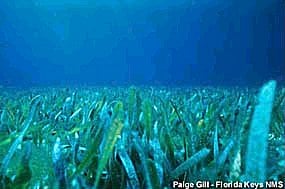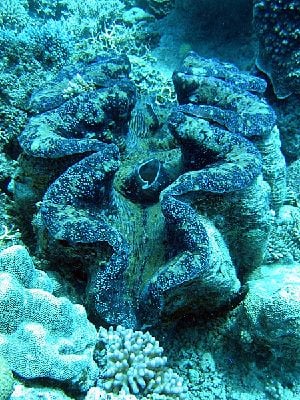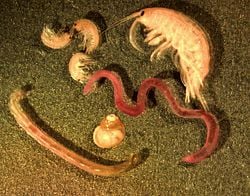Benthic zone
The benthic zone is the ecological region at the lowest level of a body of water such as an ocean or a lake, including the sediment surface and some sub-surface layers. Organisms living in this zone are called benthos. They generally live in close relationship with the substrate bottom; many such organisms are permanently attached to the bottom. Generally, these include life forms that tolerate cool temperatures and low oxygen levels, but this depends on the depth of the water. For information on animals that live in the deepest areas of the oceans see aphotic zone. The superficial layer of the soil lining the given body of water is an integral part of the benthic zone, as it influences greatly the biological activity which takes place there. Examples of contact soil layers include sand bottoms, rock outcrops, coral, and bay mud.
For comparison, the pelagic zone is the descriptive term for the ecological region above the benthos, including the water-column up to the surface. Depending on the water-body, the benthic zone may include areas which are only a few inches below water, such as a stream or shallow pond; at the other end of the spectrum, benthos of the deep ocean includes the bottom levels of the oceanic abyssal zone.
Organisms
Benthos are the organisms which live in the benthic zone, and are different from the elsewhere in the water column. Many are adapted to live on the substrate (bottom). In their habitats they can be considered as dominant creatures. Many organisms adapted to deep-water pressure cannot survive in the upper parts of the water column. The pressure difference can be very significant (approximately one atmosphere for each 10 meters of water depth).
Because light does not penetrate very deep ocean-water, the energy source for the benthic ecosystem is often organic matter from higher up in the water column which drifts down to the depths. This dead and decaying matter sustains the benthic food chain; most organisms in the benthic zone are scavengers or detritivores.


Benthos are the organisms which live on, in, or near the seabed, also known as the benthic zone.[1] Although the term derived from the Greek for "depths of the sea",[1] the term is also used in freshwater biology to refer to organisms at the bottoms of freshwater bodies of water, such as lakes, rivers, and streams.[2]
Animals belonging to the benthos are sometimes referred to as zoobenthos, while plants are referred to as phyto-benthos.
Benthos can be categorized according to size:
- macrobenthos, size > 1 mm
- meiobenthos, size < 1 mm and > 32 µm
- microbenthos, size < 32 µm
- epibenthos lives on top of the sediment
- hyperbenthos lives just above the sediment
Benthic organisms play an important role as a food source for fish and some also for humans.
Examples of benthic organisms are sea stars, oysters, clams, sea cucumbers, brittle stars and sea anemones.
ReferencesISBN links support NWE through referral fees
- ↑ 1.0 1.1 Benthos from the Census of Antarctic Marine Life website
- ↑ About the North American Benthological Society, from that organization's website
Habitats
In oceanic environements, benthic habitats can be further subdivided based on depth. From the shallowest to the deepest are: the estuarine zone — less than 200 meters; then the bathyal zone — 200-2000 meters; the abyssal — 2000-6000 meters; and the deepest, the hadal zone — over 6000 meters.
All these zones are in deep, pressured areas of the ocean. Because of the high pressure and seclusion neither tidal changes nor human interference has had much of an effect on these areas, and the habitats have not changed much over the years. Many benthic organisms have retained their historic evolutionary characteristics; some organisms have significantly changed size[citation needed].
Humans are not able to map or observe these organisms and their habitats easily, and most observation has been done through remote controlled submarines.
See also
- Armor (hydrology)
- Deep sea
- Littoral
- Profundal zone
- Limnetic zone
- Lake stratification
- Benthos
- Stream bed
- Water column
- Intertidal zone
- Aphotic zone
- Photic zone
- Neritic zone
- Pelagic zone
References
- Fathom
- Data Archive for Seabed Species and Habitats from the UK Marine Data Archive Centre
| |||||||||||||||||||||||||||||||||||||||||||||||
Credits
New World Encyclopedia writers and editors rewrote and completed the Wikipedia article in accordance with New World Encyclopedia standards. This article abides by terms of the Creative Commons CC-by-sa 3.0 License (CC-by-sa), which may be used and disseminated with proper attribution. Credit is due under the terms of this license that can reference both the New World Encyclopedia contributors and the selfless volunteer contributors of the Wikimedia Foundation. To cite this article click here for a list of acceptable citing formats.The history of earlier contributions by wikipedians is accessible to researchers here:
The history of this article since it was imported to New World Encyclopedia:
Note: Some restrictions may apply to use of individual images which are separately licensed.
